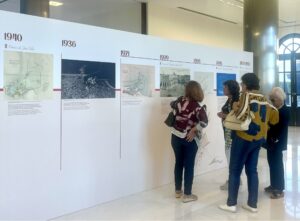
- The public has given a warm welcome to this exhibition, which explores the names of streets and squares in Valencia and its maritime neighbourhoods
- As part of the exhibition, a conference was held to commemorate the 130th anniversary of Blasco Ibáñez’s novel “Flor de Mayo” (May Flower).
- The exhibition, which is free to enter, can be visited until November 9th at the Clock Building in the Port of Valencia
Valencia, October 15th 2025 – More than a thousand people visited the Valenciaport exhibition “El Marítim, a peu de carrer” during its first week open to the public. The exhibition aims to bring to residents and visitors the living memory of the “poblats de la mar”, the maritime neighbourhoods of Valencia, whose identity has always been linked to the Mediterranean and which fill the city’s streets.
Despite the storm that occurred during the first few days of the exhibition, large numbers of visitors have come to the Clock Building, which is hosting this exhibition. Admission is free and it can be visited until November 9th. Visiting hours are from 11 a.m. to 7 p.m., Monday to Sunday.
The exhibition takes visitors on a journey through panels with text and historical images about fishing, trade, coastal defence and leisure, as factors that have transformed the port community and the city of Valencia itself, whose streets reflect part of this maritime and port history.
In this sense, as in any city, the names of streets and squares are a living reflection of its past. In this case, the exhibition collects and highlights the history of some of the current place names linked to the Maritime District of Valencia, formed by the annexation at the end of the 19th century of neighbourhoods such as Malva-rosa, Poble Nou de la Mar, Cap de França, Cabanyal, Canyamelar, Vilanova del Grau and Natzaret.
A remembrance of the anniversary of Blasco Ibáñez’s ‘Flor de Mayo’
The exhibition coincided with “Blasco Ibáñez’s Casa Museu” commemoration of the 130th anniversary of the book “Flor de Mayo”. This work, one of the Valencian writer’s first novels, narrates life in the Valencian countryside, but also in the city of Valencia at the end of the 19th century, as it winds its way through its streets.
In this context, Valenciaport wanted to join in commemorating the publication date of this novel and did so within the framework of this exhibition. Thus, during this first week, the Clock Building hosted a cultural afternoon on Blasco Ibáñez, which was the first of the events organised by the Casa Museu to commemorate the work and its author.
The event was the conference ‘Flor de Mayo: from serialised novel to film’, which traced the work’s journey from its publication in instalments to its film adaptations. The conference was attended by Emili Sales, head of the Blasco Ibáñez House Museum, and Carlos Aimeur, writer and teacher.
Aimeur, who is an expert on the work of the Valencian author, has studied the lesser-known side of the writer by analysing several of his unpublished scripts, including “Flor de mayo”. Blasco Ibáñez understood the expressive possibilities of cinema and decided to use it as a narrative form, actively participating in its early development. The importance of Vicente Blasco Ibáñez as a pioneer of cinema has always been overshadowed by his political, literary and human dimensions.
Activities for all the family
The exhibition is designed to appeal to audiences of all ages, and therefore, in addition to the information panels, it includes activities for the whole family, especially for younger children, who can visit the workshop space in the Clock Building. At tables and chairs made from recycled fishing nets, children have been able to colour in the different images from the exhibition and leave them on display in this space, creating their own exhibition.

